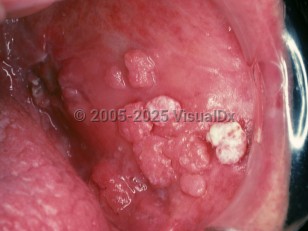Verrucous carcinoma is an uncommon subtype of
squamous cell carcinoma (SCC). Other names include verrucous squamous cell carcinoma and papillomatosis cutis carcinoides. Verrucous carcinoma presents as a well-defined, slow-growing, cauliflower-like tumorous plaque that resembles large verruca. It has been found to be associated with human papillomavirus (HPV) 16, 18, and less commonly 6 and 11. Non-HPV-associated tumors have also been reported. Verrucous carcinoma is thought to have low potential for metastasis.
Many cases of verrucous carcinoma occur in the setting of scars, amputations, and chronic inflammation. Subtypes of verrucous carcinoma are seen in particular anatomic locations:
Localized Areas of Tumor Presentation:
- Plantar foot (epithelioma cuniculatum) – Commonly develops on the ball of the foot; can destroy underlying bony structures.
- Oral cavity (oral verrucous carcinoma, Ackerman tumor) – See Verrucous carcinoma – Oral Mucosal Lesion.
- Anogenital region (giant condyloma of Buschke-Loewenstein) – Typically more aggressive; consider underlying immunosuppression. See Buschke-Lowenstein tumor.
- Nail bed (rare) – Onycholysis and shedding of the nail plate are at times present.
Verrucous carcinoma occurs more commonly in men, with a reported increased prevalence ratio of 4:1-9:1. Commonly, tumors present with slow, persistent growth over years; mean time to presentation is 13 years. Patients may experience symptoms including pain, pressure, and drainage from the keratin-filled sinuses, especially with plantar tumors. Metastases are rare due to slow, exophytic growth; however, there are rare reports of nodal and distant metastasis. Many of these cases have occurred after radiation therapy-induced anaplastic transformation of the tumor.



